Digital Window Displays and How Technology is Transforming Retail Storefronts
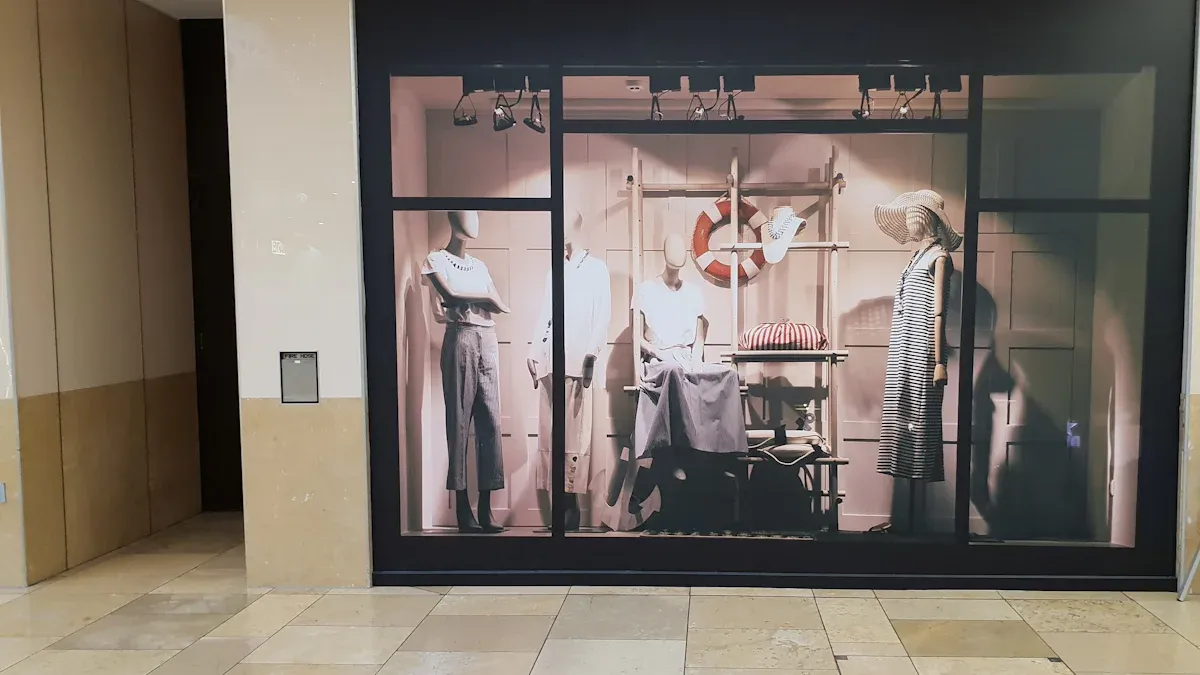
Digital window displays are changing how stores get customers’ attention. Technology is making retail displays more exciting and bright. Research shows digital window displays help more people see your store. They can make 30% more people notice your store. They also bring in 25% more people who walk inside. This change from regular signs to interactive technology helps more people see your brand. It also helps people connect with your store better.
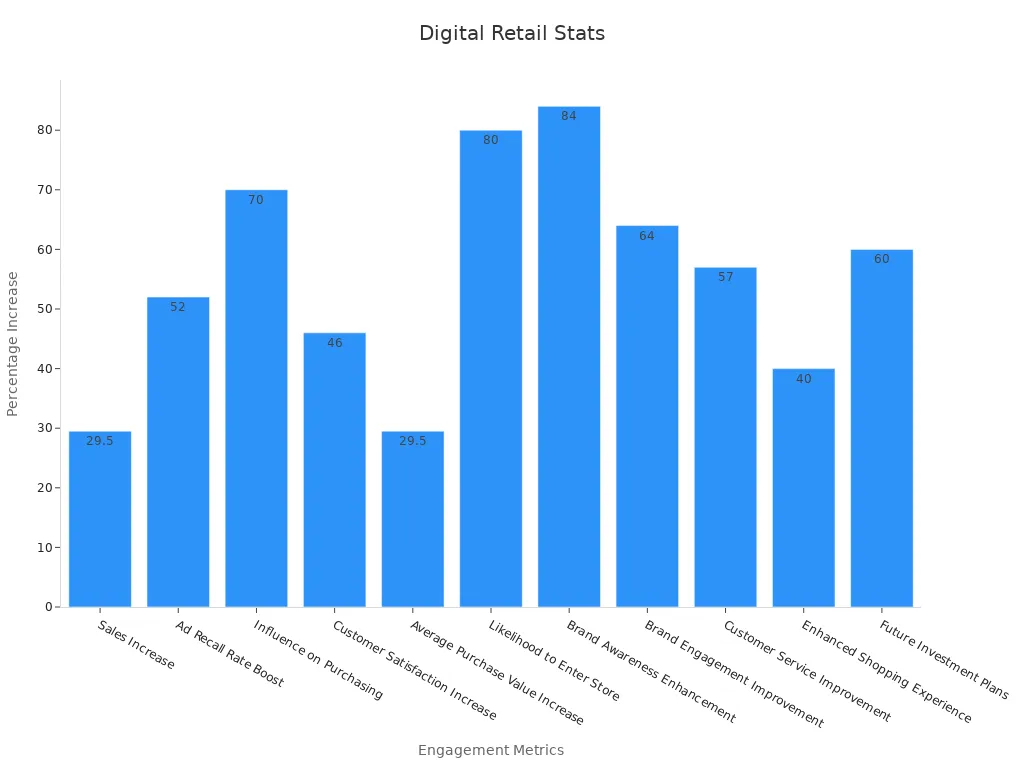
Stores using digital window displays can grow sales by up to 33%.
Digital transformation helps your brand stand out. More people remember your message and enjoy shopping.
Key Takeaways
Digital window displays bring in more customers. They use bright, moving pictures and real-time updates. This helps stores get noticed.
These displays help stores sell more and get more visitors. They show special deals, ads just for you, and fun things to watch. This keeps shoppers interested.
Interactive features like touchscreens, motion sensors, AR, and VR make shopping more fun. They help customers feel closer to your brand.
Planning your budget and picking the right technology is important. It makes sure your digital display works well and lasts longer. This also saves money over time.
Updating content often, watching how customers react, and taking care of your displays is important. This helps you get better results and keeps your store fresh and competitive.
Digital Window Displays in Retail
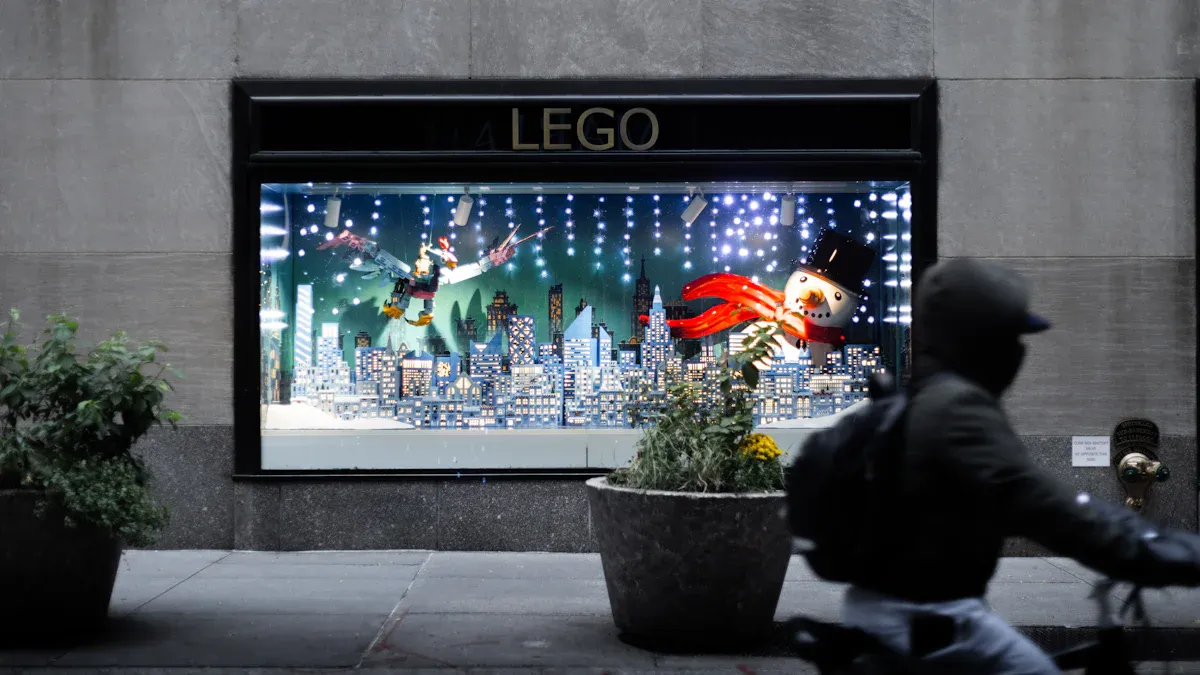
What Are Digital Window Displays
You can find digital window displays in many stores today. These displays use things like LED screens and LCD panels. They also use projection mapping to show moving pictures and ads. The screens are very bright and clear, so you can see them in sunlight. Some stores hang these displays or use touchscreens. You can touch the screen to learn about products or scan QR codes. Digital window displays fit well in store windows. Stores put them at eye level or near doors to get your attention. They last a long time because they are weatherproof and save energy. This helps stores save money. Stores can change what is on the screen fast with special software. This keeps the displays interesting and up to date.
Pick the best display for your store.
Use simple designs and bright colors to stand out.
Add fun things like QR codes or demo videos.
Change your content if customers do not react well.
Digital vs. Traditional Signage
Digital signage helps you talk to shoppers in new ways. It is different from regular signs because it moves and changes. You can show new ads, videos, or social media posts right away. This lets you keep up with trends or news quickly. Digital displays save money because you do not need to print signs. They also help the environment by making less waste. You can use tools to see how people use your displays. This helps you make your ads better. Studies say digital signs help you sell more and make shoppers happier. More people come into your store when you use digital signage.
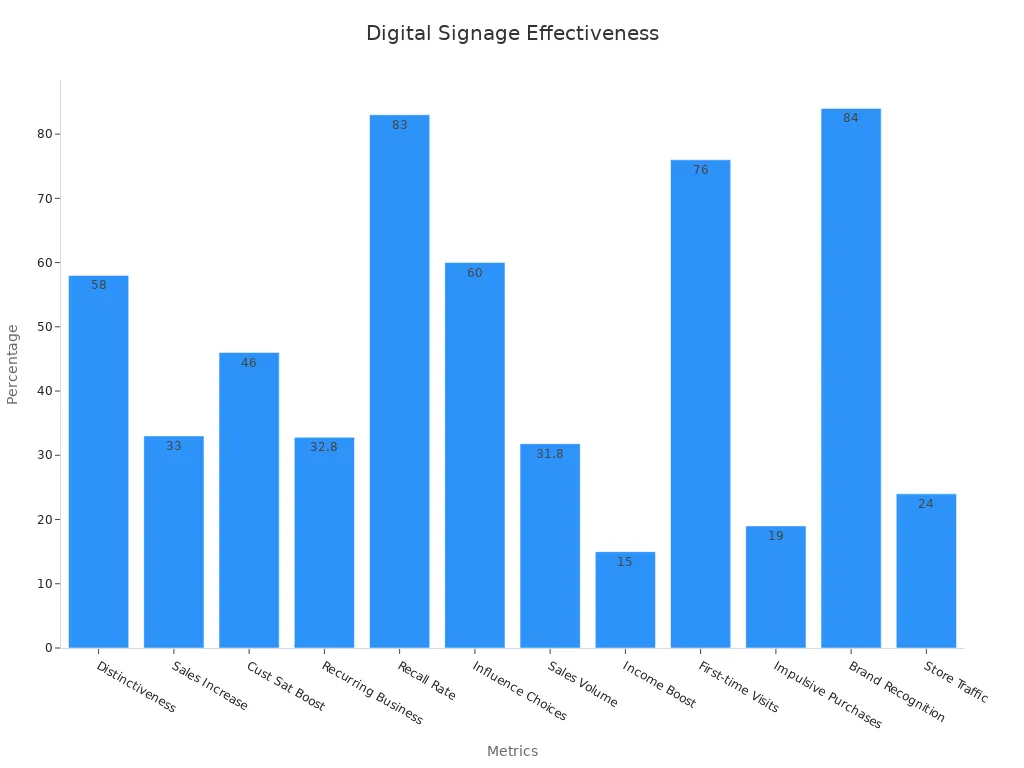
Metric | Digital Signage | Traditional Signage |
|---|---|---|
Distinctiveness | 58% | 33% |
Sales increase | Up to 33% | Baseline |
Recall rate | 83% | <83% |
Store traffic increase | Up to 24% | N/A |
Digital window displays help your store stand out and reach goals faster.
Evolution of Retail Display
Retail displays have changed a lot with new technology. Stores used to use posters or printed signs. Now, digital window displays show moving pictures to get attention. Smart mirrors, OLED screens, and projection mapping make shopping more fun. Customers can try products on screens or see new deals right away. These tools help people stay in the store longer. Some displays work with checkout systems for fast updates and special offers. Research says digital displays get 400% more views than old signs. This change makes sales, happiness, and work better. Big brands like Adidas and Tesla use digital signs to get more shoppers and sales. You can use these tools to link your online and store ads. This makes every visit to your store important.
Benefits of Digital Displays
Increased Foot Traffic
You want more people to see your store and come in. Digital displays help by using bright colors and moving pictures. They show real-time deals that catch people’s eyes. You can use them to show new products or customer reviews. These displays make your store easy to spot and help more people notice your brand.
Digital displays show special deals for a short time. This makes people want to shop quickly.
You can show clear pictures of your best products. People will not miss them.
Fun videos or how-to clips keep people watching your display longer.
You can change your message for the weather. This makes your deals fit the day.
Stores use tools to count how many people walk by or come in. This helps you know what works best to get more shoppers. You can change what is on the screen right away. This means you can follow trends or news fast. You do not need to print signs, so you save money. You always show the right message at the right time.
Tip: Use digital displays to show your team or tell local stories. This helps people trust you and feel welcome in your store.
Personalization and Targeted Content
You can make your display better by showing messages for certain people. Digital displays use data to learn what shoppers like. You can show different ads at different times or for different people. This makes your ads work better and gets more people interested.
Targeted ads on digital displays get more clicks than normal ads.
Personalized messages help more people buy and fewer people leave.
Shoppers are more likely to come back after a personal shopping trip.
Stores using personalization can get much more money back.
You can plan deals for different groups of shoppers. For example, show family deals in the afternoon and tech deals at night. Special messages help you talk to shoppers and make their visit better. When you use digital displays for targeted content, your store always feels new and interesting.
Enhanced Brand Storytelling
Digital displays help you tell your brand’s story in new ways. You can use videos and moving pictures to show what makes your store special. This helps connect your online and in-store ads. It gives shoppers a smooth experience.
Spotify’s “Spotify Wrapped” is a good example. Spotify used digital displays to show people their music habits in a fun way. This made people feel part of the brand and got them more involved. Studies say digital stories with strong pictures make people trust your brand and want to buy.
You can use your display to show customer stories or introduce your team. This helps shoppers feel closer to your store and have a better time. Digital displays help you make moments people remember, so they want to come back.
Note: Digital displays can show many messages and change fast. This lets you share your story in fun ways and helps more people see your store.
Interactive and Immersive Digital Signage
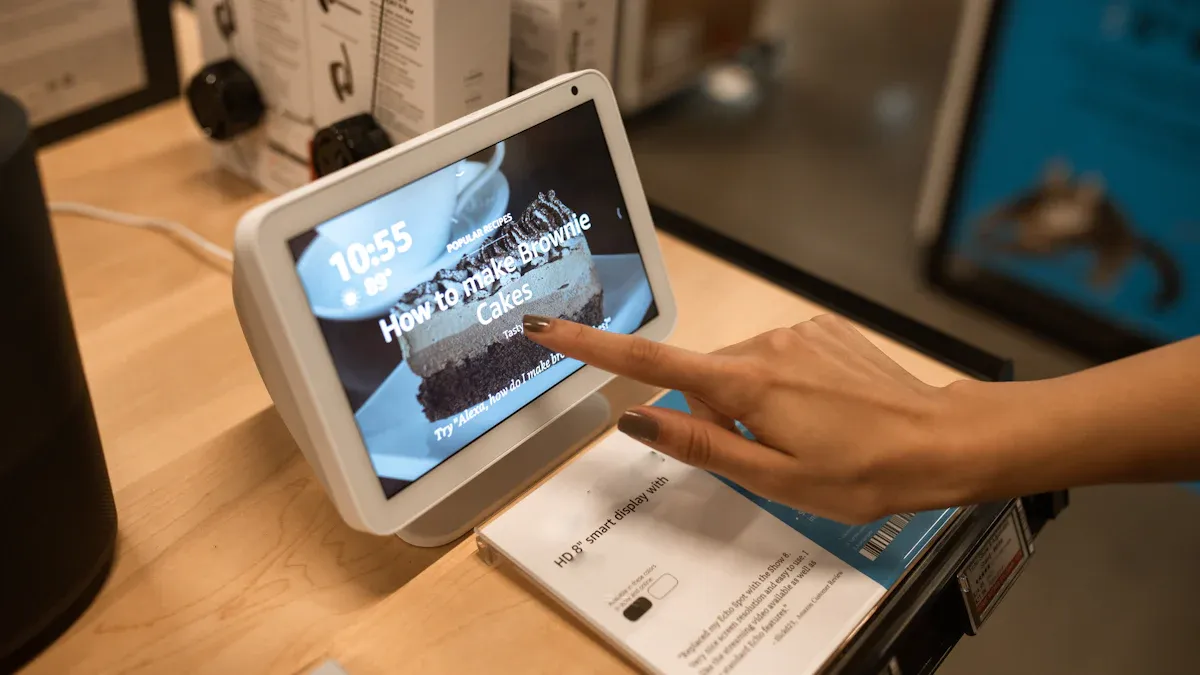
Touch and Motion Features
You can make your store windows fun with interactive window advertising. Touchscreens let shoppers look at products or find deals. They can also ask questions on the screen. Motion sensors notice when someone walks by and show special content. This digital technology helps you get people’s attention and keep them interested. Smart fitting rooms use touchscreens so shoppers can ask for sizes or see style ideas. Museums use motion tracking to teach visitors with fun displays. In stores, digital signage with touch and motion features can help more people buy things, up to 30% more.
Touch Feature Metric | Description |
|---|---|
Tap Accuracy and Repeatability | Checks if the screen can find taps in the same spot every time. |
Swipe Accuracy | Makes sure the screen follows your finger when you swipe. |
First Contact Latency | Shows how fast the screen reacts when you touch it. |
Hover Distance | Finds out how close your finger needs to be for the screen to work. |
Interactive window advertising lets you try new ideas and see what works. You can change the display fast and watch how people react.
AR and VR Integration
You can use digital technology like AR and VR to make shopping more exciting. AR lets shoppers see how a sofa looks in their home or try on glasses without touching them. VR lets customers visit a virtual store and look at products. These tools help people feel sure about what they want to buy. Studies say that using VR makes people want to buy more because they understand products better. Interactive window advertising with AR and VR helps your store stand out and brings shoppers back.
Tip: Use AR so customers can scan a code and see more product details or videos on their phones.
Connected Customer Journey
Digital signage helps you make shopping easy from start to finish. You can use interactive window advertising to welcome shoppers, show deals, or guide them to new products. Digital technology tracks what people look at and how they use your displays. This helps you show the right message at the best time. Research says digital signage can help more people pay attention and buy, up to 40% more. You can use analytics to see which displays work best and change your content. Interactive features like QR codes and touchscreens make shopping simple and personal. When you connect your online and in-store shopping, you build trust and keep customers coming back.
Implementing Digital Window Displays
Costs and ROI
You need to plan your budget before you install digital window displays. The first cost is higher than regular signs, but you save money over time. For example, a store might spend $3,000 on digital signage at first. The yearly update cost is about $500, much less than printing new signs every month. You also spend on software and maintenance. Many stores see a big return on investment. One store spent $5,000 and made $15,000 more in sales, which means a 124% ROI.
Cost Type | Traditional Signage | Digital Signage |
|---|---|---|
Initial Cost | £800 | £3,000 |
Annual Update Cost | £3,600 | £500 |
Total First-Year Cost | £4,400 | £3,500 |
You can measure success by tracking foot traffic, sales, and how many people interact with your display. Digital displays help you reach more people and increase sales. You can also use surveys to learn what customers think.
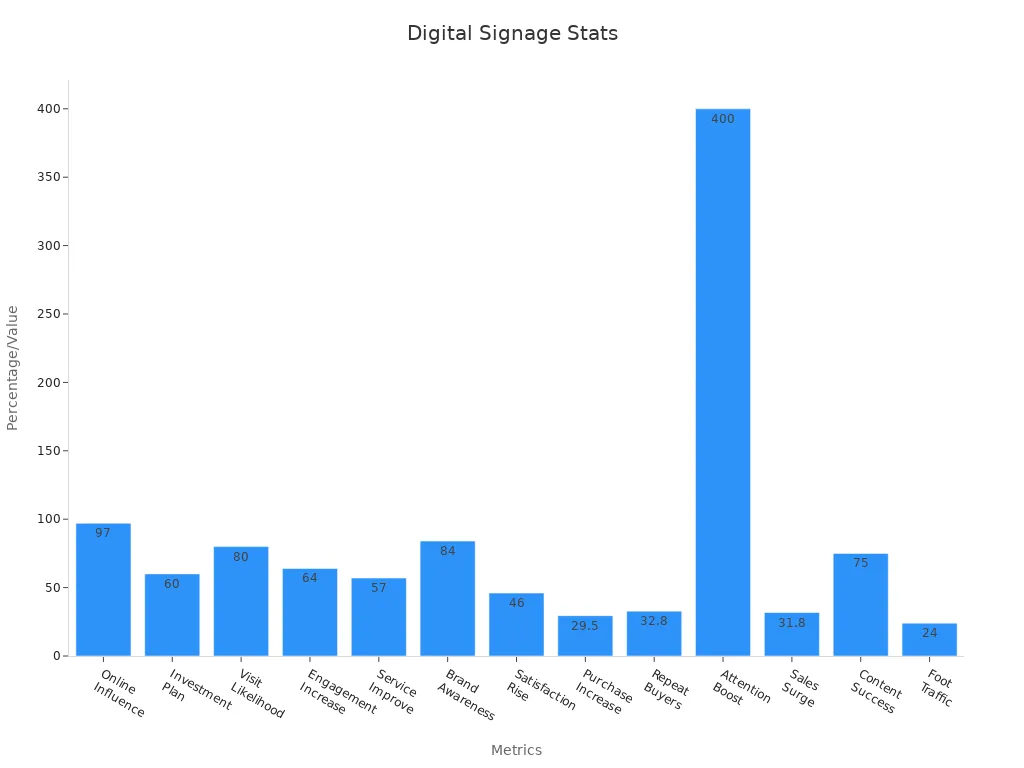
Overcoming Challenges
You may face some problems when you set up new technology. Sometimes, the internet is slow or the power goes out. You might need to train your team to use the new system. Some stores have trouble finding the right spot for their screens. You also need to keep your data safe and make sure the display works with your other tools.
Tip: Work with experts who know how to install and maintain digital displays. They can help you solve problems fast.
You should check your system often. Make sure the display is clean and the software is up to date. If you have trouble, ask for help from your provider.
Best Practices
To create an effective digital window display, you should follow some simple rules:
Use large, clear text so people can read it from far away.
Pick two or three fonts and use strong color contrast.
Keep animations simple and do not use too many colors.
Place your display where people can see it easily.
Make sure your hardware and software work well together.
Test your display before you go live.
Update your content often to keep it fresh.
Clean your screens and check for problems every week.
Plan for the future by choosing technology that can grow with your store.
Note: Good planning and regular checks help your display work better and last longer.
Getting Started with Retail Digital Displays
Assessing Store Needs
You should know what your store needs before you add digital window displays. First, find out where your data comes from. Check who visits your store and see if anyone is missing from your data. Look at your old data to find any mistakes or missing parts. Compare your results with local people to make sure you include everyone. Talk with your team in meetings to find out what problems you want to fix. Set up ways to get feedback so you can keep making things better. Collect ideas from customers who use touchscreens or scan QR codes. These steps help you make a display system that matches your store’s goals and helps your shoppers.
Tip: Watch for feedback from your displays to see new trends and change your content fast.
Choosing Technology
Think about your store and your shoppers when picking digital display technology. LED screens are good for bright windows. LCD panels work best inside. If your store gets a lot of sun, choose screens with high brightness, at least 1,500 nits. In cold or rainy places, use strong screens and safe mounts. Always check the rules in your area before putting up outdoor signs. Pick software that is easy to update and lets you change things quickly. Use mobile tools like QR codes to get shoppers involved. Work with partners who can help you set up and fix your displays. This makes your display last longer and work well.
Look at different hardware choices (LED or LCD)
Make sure your screens can handle bad weather and are safe
Choose software that is simple to use and update
Measuring Success
You need to see how well your digital window displays are working. Start by looking at sales and how many people come in before and after you add the displays. Use tools like cameras or people counters to see how many walk by, stop, or enter your store. Track how many shoppers use your display to measure interest. Check how many people who look at your display end up buying something. You can also ask shoppers what they think with surveys or Net Promoter Scores. Some stores have seen sales go up by 171% for special products after using digital displays. These results show that digital displays can help your store sell more.
Metric | What to Track |
|---|---|
Exposure | Passersby near the display |
Engagement | People stopping to look |
Conversion | Shoppers entering the store |
Sales Lift | Increase in product sales |
Digital window displays change how you connect with shoppers. You can use touch screens, AR, and AI to create fun, personal shopping experiences. Real-time updates and data help you show the right message and boost sales.
You save energy and cut waste with new display tech.
Large, bright screens and 4K visuals make your brand stand out.
AI and analytics let you adapt fast and stay ahead.
The future of retail belongs to stores that use smart, interactive displays. Start now to keep your store fresh, competitive, and ready for tomorrow.
FAQ
What is a digital window display?
A digital window display uses screens to show videos, images, or messages in your store window. You can update the content quickly. These displays help you attract more people and share information in real time.
How do digital displays increase sales?
Digital displays catch people’s eyes with bright colors and movement. You can show special deals or new products. This makes shoppers want to come inside. Many stores see higher sales after adding digital displays.
Are digital window displays hard to maintain?
You can keep digital displays running with simple care. Clean the screens often. Update the software when needed. Most systems send alerts if something goes wrong. Many providers offer support to help you fix problems fast.
Can I use digital displays for small stores?
Yes, you can use digital displays in small stores. Choose a screen size that fits your space. Start with simple content. You do not need a big budget. Even small displays can help you stand out and attract more customers.
See Also
Exploring Technology And Benefits Of Digital Window Displays
How Retailers Boost Foot Traffic With Digital Window Displays
The Effect Of Digital Signage On Customer Engagement Levels
How Digital Signage Technology Transforms Communication Strategies
Best LED Digital Signage Solutions For Retail Settings Today

